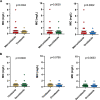In Vitro Effect of 5-Nitroimidazole Drugs against Trichomonas vaginalis Clinical Isolates
- PMID: 35863010
- PMCID: PMC9430554
- DOI: 10.1128/spectrum.00912-22
In Vitro Effect of 5-Nitroimidazole Drugs against Trichomonas vaginalis Clinical Isolates
Abstract
Infections with the sexually transmitted parasite Trichomonas vaginalis are normally treated with metronidazole, but cure rates are suboptimal and recurrence rates following treatment are high. Therefore, our objective was to assess the in vitro antitrichomonas activities of three other 5-nitroimidazole drugs and compare them with metronidazole. T. vaginalis isolates (n = 94) isolated from South African women presenting with vaginal discharge syndrome at two sexually transmitted disease clinics in KwaZulu-Natal were grown from frozen stock. Twofold serial dilutions (16 to 0.25 mg/L) of metronidazole, tinidazole, ornidazole, and secnidazole were prepared in Diamond's broth. The MICs were read after 48 h of anaerobic incubation at 37°C. An MIC of <2 mg/L was defined as susceptible, an MIC of 2 mg/L was defined as intermediate, and an MIC of >2 mg/L was defined as resistant. Sixty-one percent (57/94) of the T. vaginalis isolates were susceptible to metronidazole, 80% (75/94) were susceptible to tinidazole, 75% (71/94) were susceptible to secnidazole, and 89% (84/94) were susceptible to ornidazole. Resistance levels were 11%, 2%, and 1% for metronidazole, tinidazole, and secnidazole, respectively, while no resistance was observed for ornidazole. Intermediate scores were 28% for metronidazole, 18% for tinidazole, 24% for secnidazole, and 11% for ornidazole. Isolates from a proportion of women with bacterial vaginosis (BV) had higher MICs, and no isolates from women coinfected with another sexually transmitted infectious organism were resistant to any of the antimicrobials tested. This study showed that among T. vaginalis isolates in KwaZulu-Natal, there is no in vitro resistance to ornidazole. Of the 5-nitroimidazoles, metronidazole showed the highest level of resistance. The very low levels of resistance for the other three antimicrobials indicate that all three are viable options as a replacement for metronidazole if these in vitro findings are found to correlate with clinical outcomes. IMPORTANCE Trichomonas vaginalis is the most common nonviral sexually transmitted infection associated with reproductive sequelae and HIV acquisition risk worldwide. Despite its role in reproductive health, a high prevalence in South Africa, and the reported metronidazole resistance worldwide, no alternative regimens have been tested against T. vaginalis in our setting. This study compared the susceptibility patterns of three other 5-nitroiminazoles (secnidazole, tinidazole, and ornidazole), which are active against T. vaginalis with metronidazole in vitro. Metronidazole, the drug of choice for the treatment of trichomoniasis, showed the highest level of resistance, while the three regimens showed very low levels of resistance. These data indicate that all three are viable options as a replacement for metronidazole if these in vitro findings are found to correlate with clinical outcomes.
Keywords: Trichomonas vaginalis; in vitro; metronidazole; nitroimidazoles; susceptibility testing.
Conflict of interest statement
The authors declare no conflict of interest.
Figures



Similar articles
-
Nitazoxanide and tizoxanide demonstrate high levels of in vitro activity against metronidazole-susceptible and metronidazole-resistant Trichomonas vaginalis clinical isolates.Microbiol Spectr. 2025 Jul;13(7):e0271724. doi: 10.1128/spectrum.02717-24. Epub 2025 May 22. Microbiol Spectr. 2025. PMID: 40401974 Free PMC article.
-
In Vitro Study of the Susceptibility of Clinical Isolates of Trichomonas vaginalis to Metronidazole and Secnidazole.Antimicrob Agents Chemother. 2018 Mar 27;62(4):e02329-17. doi: 10.1128/AAC.02329-17. Print 2018 Apr. Antimicrob Agents Chemother. 2018. PMID: 29439963 Free PMC article.
-
[In vitro susceptibility of Trichomonas vaginalis to metronidazole, ornidazole and proton pump inhibitors pantoprazole and esomeprazole].Mikrobiyol Bul. 2016 Jan;50(1):133-9. Mikrobiyol Bul. 2016. PMID: 27058337 Turkish.
-
Persistent and recurrent Trichomonas vaginalis infections: epidemiology, treatment and management considerations.Expert Rev Anti Infect Ther. 2014 Jun;12(6):673-85. doi: 10.1586/14787210.2014.887440. Epub 2014 Feb 20. Expert Rev Anti Infect Ther. 2014. PMID: 24555561 Review.
-
A systematic review of the literature on mechanisms of 5-nitroimidazole resistance in Trichomonas vaginalis.Parasitology. 2020 Nov;147(13):1383-1391. doi: 10.1017/S0031182020001237. Epub 2020 Jul 30. Parasitology. 2020. PMID: 32729451 Free PMC article.
Cited by
-
Impact of COVID-19 Pandemic on the Trends of Trichomonas vaginalis Infection in a Tertiary Hospital of Madrid, Spain.Microorganisms. 2024 Mar 20;12(3):620. doi: 10.3390/microorganisms12030620. Microorganisms. 2024. PMID: 38543671 Free PMC article.
-
Infinity war: Trichomonas vaginalis and interactions with host immune response.Microb Cell. 2023 Mar 30;10(5):103-116. doi: 10.15698/mic2023.05.796. eCollection 2023 May 1. Microb Cell. 2023. PMID: 37125086 Free PMC article. Review.
-
Tinidazole vs metronidazole for the treatment of bacterial vaginosis: a systematic review and meta-analysis.Arch Gynecol Obstet. 2025 Feb;311(2):333-340. doi: 10.1007/s00404-024-07899-z. Epub 2025 Feb 19. Arch Gynecol Obstet. 2025. PMID: 39969560 Free PMC article.
-
Trichomoniasis.Infect Dis Clin North Am. 2023 Jun;37(2):245-265. doi: 10.1016/j.idc.2023.02.001. Epub 2023 Mar 31. Infect Dis Clin North Am. 2023. PMID: 37005163 Free PMC article. Review.
-
A fluorescence-based assay for Trichomonas vaginalis drug screening.Parasit Vectors. 2023 Sep 18;16(1):329. doi: 10.1186/s13071-023-05919-6. Parasit Vectors. 2023. PMID: 37723582 Free PMC article.
References
-
- WHO. 2021. Global progress report on HIV, viral hepatitis and sexually transmitted infections, 2021. World Health Organization, Geneva, Switzerland.
-
- Francis SC, Mthiyane TN, Baisley K, Mchunu SL, Ferguson JB, Smit T, Crucitti T, Gareta D, Dlamini S, Mutevedzi T, Seeley J, Pillay D, McGrath N, Shahmanesh M. 2018. Prevalence of sexually transmitted infections among young people in South Africa: a nested survey in a health and demographic surveillance site. PLoS Med 15:e1002512. doi:10.1371/journal.pmed.1002512. - DOI - PMC - PubMed
Publication types
MeSH terms
Substances
LinkOut - more resources
Full Text Sources
Molecular Biology Databases

